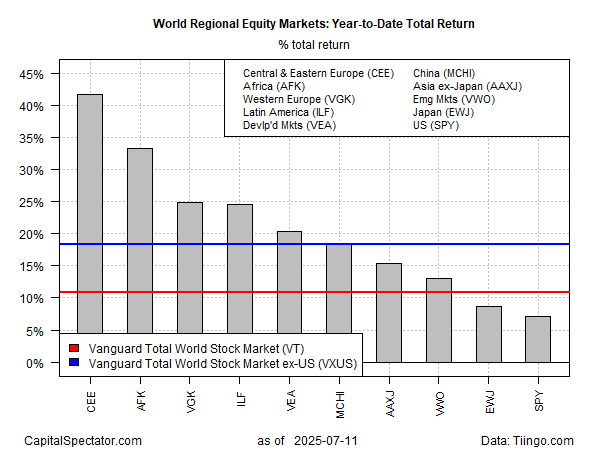Senate Republicans to challenge auto safety mandates in January - WSJ
A single decision has been crucial for a global equities strategy this year: selecting the weights for foreign vs. US stocks. The higher the weight in shares outside the US, the higher the performance so far in 2025. But as President Trump presses ahead with plans to raise tariffs, it’s reasonable to wonder if the gravy train in foreign stocks will persist in the face of an aggressive US trade policy.
Year to date, the numbers certainly favor shares outside America. Using a set of ETFs, the US stock market trails the rest of the world this year, as of Friday’s close (July 11). The question is whether a sharp rise in US tariffs is more than a negotiating tactic and instead will be a permanent feature? If so, how will this shift affect the global trading system and which countries will bear the brunt of the fallout?
No one knows, at least not yet. Trump’s trade policy, such as it is, remains volatile and subject to quick changes at the President’s discretion. But in recent days, he’s sent letters to several countries – including major trading partners.
On Saturday, for example, he advised that the US will impose a 30% tariff on goods from the European Union and Mexico as of Aug 1. On Thursday, Trump announced a 35% tariff on Canada. A few days earlier, he said targeted Japan and other countries for higher tariffs next month.
The recent assumption is that the TACO trade applies – shorthand for Trump Always Chickens Out. One theory is that the threats and bluster are a negotiating tactic that ultimately gives Trump what he wants. But investors are starting to wonder if the end goal is higher tariffs rather than a tortured path to new trade deals that favor low tariffs.
The challenge is that it’s not exactly clear what Trump wants. Is it a new global trading order with low or zero tariffs? Is it the elimination of the US trade deficit? The reshoring of manufacturing production? Unfortunately, achieve two or three of these objectives is challenging, if not impossible, say economists.
To date, trade negotiations are ongoing and the administration says new deals are possible. But Trump’s recent comments raise doubt about whether trade deals are the objective.
“Everybody has to pay and the incentive is that they have the right to deal in the United States. If they don’t want to, they don’t have to pay,” he said during a cabinet meeting last week.
If higher US tariffs are here to stay, what are the implications for foreign stocks? Unclear, in part because the details on trade policy remain as uncertain as ever.
Meanwhile, foreign leadership in equities relative to the US is fading again, based on the ratio of two ETFs: a fund that holds the world’s equities ex-US (VXUS) vs. the US benchmark via {{525|SPDR S&P 500 ETF}} (SPY). The sharp rise in this ratio (indicating outperformance for VXUS over SPY) earlier in the year has reversed. Periodic but short-lived runs of foreign-stock outperformance have occurred in recent years (late-2022/early 2023, for instance).
Is this time different? A non-trivial factor that will influence an answer will play out in the days and weeks ahead by the self-proclaimed “tariff man.”
Perhaps the only thing that’s certain, or near certain, is that higher US tariffs in some degree look increasingly likely. In turn, that has implications for economic activity, in the US and around the world.
“The effective tariff rate for all imports coming into the US, if you calculated an average across the board, would be about 15%,” said Amundi’s head of global macro Mahmood Pradhan. “This is broadly negative for growth in every country that is involved in world trade.”
